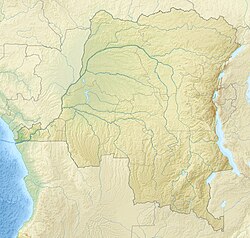Tanganika-Moero District
Tanganika-Moero District | |
|---|---|
District | |
| Coordinates: 5°55′00″S 29°12′00″E / 5.916667°S 29.2°E | |
| Country | Belgian Congo |
| Province | Katanga |
| District | Tanganika-Moero |
Tanganika-Moero District (French: District du Tanganika-Moero, Dutch: District Tanganika-Moero) was a district of the Belgian Congo from 1912 to 1933, when it was dissolved. It roughly corresponded to the present Tanganyika Province and the northern part of Haut-Katanga Province.
Location
[edit]Parts of the Stanley Falls and Lualaba districts were combined to form Katanga in 1910, which was called a vice-government general.[1] An arrêté royal of 28 March 1912 divided the Congo into 22 districts.[2] A map of the colony after this division shows Tanganika-Moero District bordered by British territories and Lake Tanganyika to the east, Kivu and Maniema districts to the north, Lomami and Lulua districts to the west and Haut-Luapula District to the south.[3] The district was named after Lake Tanganyika and Lake Mweru, which bordered the district to the east and south respectively.
Katanga become a vice-government in 1913.[4] It contained the districts of Lomami, Tanganika-Moero, Lulua and Haut-Luapula.[3] In 1933 the provinces were reorganized into six provinces, named after their capitals, and the central government assumed more control.[5] Katanga became Elisabethville Province. The number of districts in the colony was reduced to 15, with 102 territories.[4] The northern part of Tanganika-Moero became Tanganika District, while the southern part was absorbed by Haut-Katanga District.[3]
On 11 July 1960, a few days after the Congo Republic had gained independence, the province of Katanga seceded as an independent state.[6] In November 1961 the northern portion was reconquered by the national government and made the province of Nord-Katanga. On 21 January 1963 the remainder of Katanga was reconquered and divided into the provinces of Lualaba and Katanga Oriental.[6] Nord-Katanga, Lualaba and Katanga Oriental were merged back into the province of Katanga on 28 December 1966. [6] In 2015 Tanganyika Province was formed from the Tanganyika district, whose town of Kalemie was elevated to capital city of the new province.
Maps
[edit]-
1910 districts after formation of Katanga in the southeast
-
1912 districts including Tanganika-Moero in the northeast of Katanga
-
1933 provinces and districts after Haut-Luapula was dissolved
-
The present Tanganyika Province
-
The present Haut-Katanga Province
See also
[edit]References
[edit]- ^ Lemarchand 1964, pp. 62–63.
- ^ Lemarchand 1964, p. 63.
- ^ a b c Atlas général du Congo.
- ^ a b Lemarchand 1964, p. 64.
- ^ Bruneau 2009, p. 8.
- ^ a b c Congo (Kinshasa) Provinces.
Sources
[edit]- Atlas général du Congo / Algemene atlas van Congo (in French and Dutch), Belgium: Institut Royal Colonial Belge, 1948–1963, OCLC 681334449
- Bruneau, Jean-Claude (30 June 2009), "Les nouvelles provinces de la République Démocratique du Congo : construction territoriale et ethnicités", L'Espace Politique, 7 (2009–1), doi:10.4000/espacepolitique.1296, retrieved 2020-08-08
- "Congo (Kinshasa) Provinces", Rulers.org, retrieved 2020-08-05
- Lemarchand, René (1964), Political Awakening in the Belgian Congo, University of California Press, GGKEY:TQ2J84FWCXN, retrieved 19 August 2020






